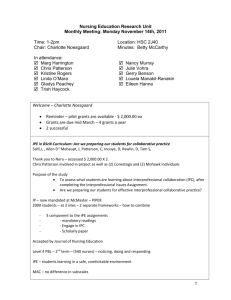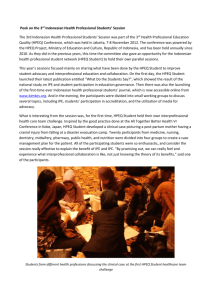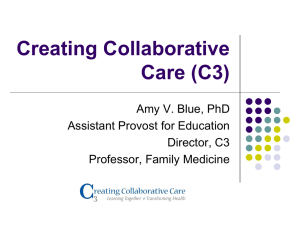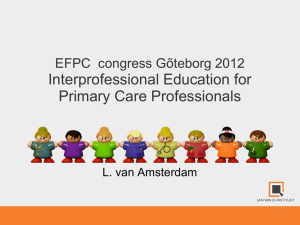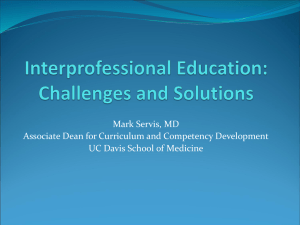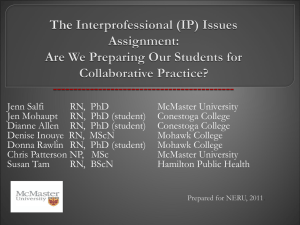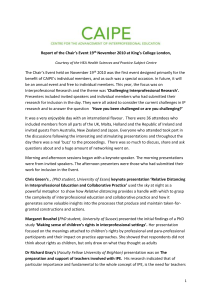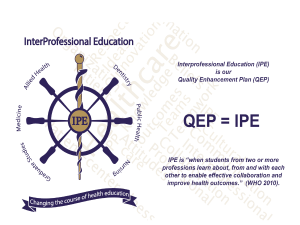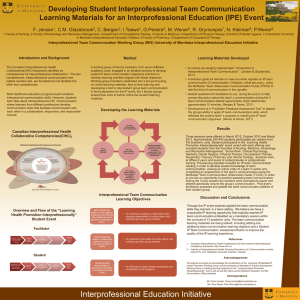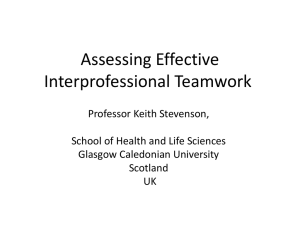(IPE) in the B.Sc.N Curriculum
advertisement
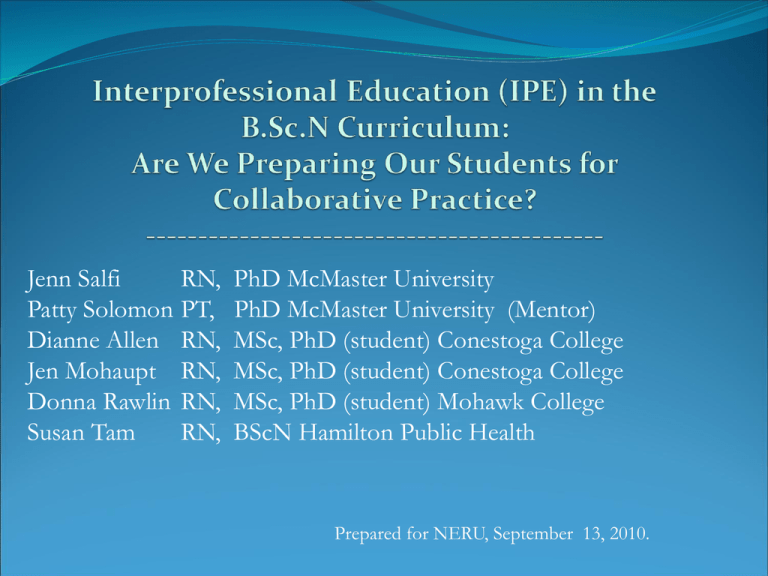
Jenn Salfi RN, Patty Solomon PT, Dianne Allen RN, Jen Mohaupt RN, Donna Rawlin RN, Susan Tam RN, PhD McMaster University PhD McMaster University (Mentor) MSc, PhD (student) Conestoga College MSc, PhD (student) Conestoga College MSc, PhD (student) Mohawk College BScN Hamilton Public Health Prepared for NERU, September 13, 2010. -Background -Current State of the Literature -Interprofessional Education (IPE) -IPE & the BScN Curriculum -Purpose of IP Issues Assignment & Study -Methodology -Timeline -Questions Issue: Organization & delivery of care is becoming more complex and challenging: increase in chronic illness and disease decrease in human resources decrease in financial resources IPC : Interprofessional Collaboration: “ is the process of developing and maintaining effective interprofessional working relationships with other professionals, alongside the patient/client and their families, to enable optimal health outcomes.” (CIHC, 2010) IPE : Interprofessional Education: “occurs when two or more professions learn with, from and about each other in order to improve collaboration and the quality of care” (CAIPE, 2002) -WHO (2010): IPE is an essential step in preparing a “collaborative practice-ready” workforce -CIHC (2010): IPE...key to building effective health care teams; improving the experience and outcomes of patients -HFO (2010): IPE...build the foundation upon which key interprofessional care activities can be implemented & sustained “If health care providers are expected to work together and share expertise in a team environment, it makes sense that their education and training prepare them for this type of working arrangement.” (Roy Romanow, 2002). Current Status of IPE (Canada): -Elective IPE courses & projects (UBC) -Compulsory IPE course (U of A) -Rural Palliative Care Program (U of O) -Compulsory IP Learning Modules (Dalhousie) -Compulsory & Elective Courses (Memorial) -Elective & Compulsory IP activities (McMaster) (Ho et al., 2008). -Up until September 2009 – nil -Interprofessional Issues Assignment (Sept.09) -Proposed Framework (Conestoga, McMaster IPE competencies) Level 1 Strategy: Intra- professional Education & the Foundation of Group Skills Level 2 Strategy: Introduction to IPC/IPE & Exposure to the Health Care Team Level 3 Strategy: Interprofessional Collaboration Level 4 Strategy: Becoming an Effective Member of the Health Care Team -Introduces students to IP, team-based literature -Introduces students to IP issues -Opportunity to achieve ¾ of the required IPE competencies -Opportunity to collaborate with others (professionals/students) -Promotes reference to the CNO (2009) National Competencies 1. Mandatory Readings: 1. 2. -CIHC (2010) National Interprofessional Competency Framework -Suter et al (2009) Importance of Role Clarity & Communication in IPC 2. Engage in IPC 1. 2. 3. -Must involve > 2 professions (student or professional) -Must be interactive (immersion level) Scholarly Paper 1. 2. 3. -Select an IP Issue -Background Information; Impact of Issue -Identifies Areas for Professional Development; Proposes Strategies (skills, knowledge & behaviours still required for IPC) -To assess what students are learning about IPC, after completing the Interprofessional Issues Assignment (4Q04). -What skills, knowledge, and behaviors are the students gaining from this assignment? -Are we preparing our students for effective interprofessional collaborative practice? -Embedded mixed method study design: Qualitative data will augment the primary source of data (Quantitative data) - Quantitative component: Will monitor general changes in attitudes and perceptions re: IPC - Qualitative component: Will add “meaning” & elaborate on what the students are learning from the assignment - By collecting both quantitative and qualitative sources of data, one can develop a more complete picture of the phenomenon (Creswell, 2008). Quantitative: Does the Interprofessional Issues Assignment have an effect on Level 4 students’ perceptions and attitudes regarding interprofessional collaboration? Qualitative: How do Level 4 B.Sc.N students experience the Interprofessional Issues Assignment? Overall Question for Mixed Methods study: What is the impact of the IP Issues Assignment, in developing attitudes and knowledge required for interprofessional collaborative practice among Level 4 B.Sc.N students? Quantitative component: -Four demographic questions ( age, gender, stream, site) -Questionnaire administered before/after completion of the IP Issues Assignment -Questionnaire: Interdisciplinary Education Perception Scale (IEPS) Analysis: -Statistical Package for Social Sciences (SPSS) -Paired sample t-tests: Changes in IEPS scores before/after assignment ? -ANOVA: Differences based on age, gender, B.SC.N stream and site? Qualitative component: -Five focus groups (total of 25 students) -Semi-structured interviews (3 questions; audio-taped; notes) -Purposeful sampling: 5 students from each site (Conestoga, Mohawk, McMaster) 5 students representing the post practitioner streams (Post RN/RPN) 5 students representing the Accelerated stream Ethical Considerations: -Awaiting approval from the HHS/FHS Research Ethics Board -Coordinated ethics review process -Awaiting approval from Undergraduate Nursing Education Committee (UNEC) -Completely voluntary; no effect on assignment or course grade -Completely anonymous (mother’s maiden name; number) Ethics: Special Considerations (PI=CP=Tutor) -Level 4 student “leaders”: review & collect consent forms; administer , collect & deliver questionnaires -Students from PI’s group will be excluded from the quantitative component of this study -Questionnaires delivered to PI in a sealed/signed envelope -Anonymized by research team (excluding PI) -PI will only see data after it has been assigned a number -Ethics/UNEC Approval: Fall 2010 -Letter of Invitation: December 2010 & January 2011 -Recruitment of student “leaders”: December 2010 -Pre-questionnaires: Tutorial#2 - Week of January 10, 2011 -Post questionnaires: Tutorial#9 - Week of March 7, 2011 (after class has ended; in PBL class room; 5 mins.) -All questionnaires anonymized by research team (excl. PI) end of March/beg. of April 2011 Quantitative Data Analysis: Spring/Summer 2011 -Report to NERU: Fall 2011
